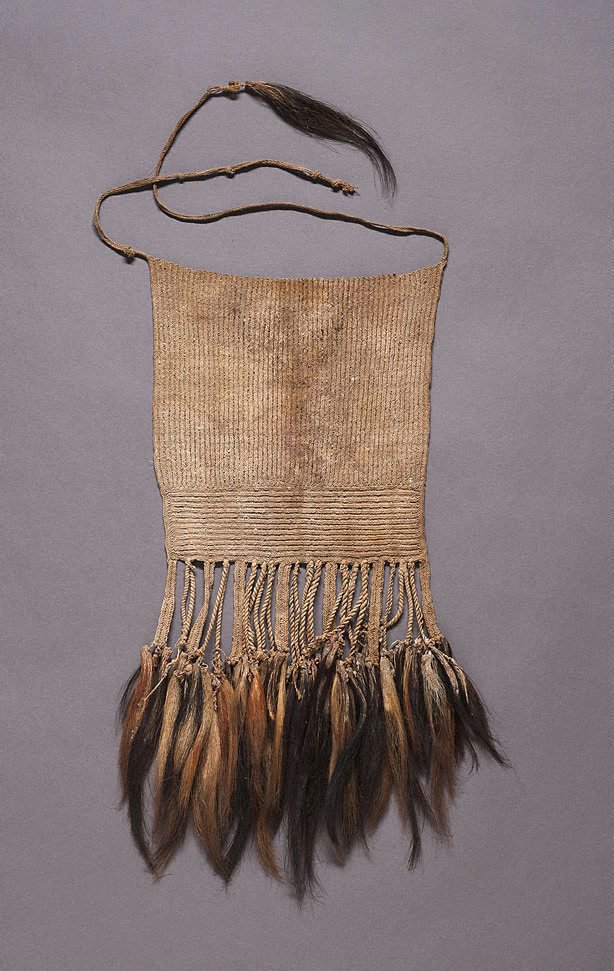-
Details
- Other Titles
- Sporan
Sporran - Place where the work was made
-
Laiagam
→
Enga Province
→
Papua New Guinea
- Cultural origin
- Enga people
- Date
- collected 1965
- Media categories
- Botanical material , Animal material
- Materials used
- 2-ply plant fibre string, clay, 71 pigs' tails
- Dimensions
-
56.0 cm length; 27.0 cm width across top; 118.0 cm waistband length
:
0 - Whole, 56 cm (22 1/16")
0 - Whole, 27 cm (10 5/8"), width across top
0 - Whole, 118 cm (46 7/16"), length of waistband
- Credit
- Gift of Stan Moriarty 1977
- Location
- Not on display
- Accession number
- 846.1979.1
- Copyright
- Share
-
-
About
The apron adorner is a pig-tail-fringed piece of knitting, varying in size and shape, from relatively small and triangular ... to large and rectangular, with long pig-tail-bedecked streamers. Regardless of size and shape the constant feature of adorners is the pigs' tails hanging along one side. Men wear them tucked into their bark girdles by two side straps, dangling sporran-like in front of their aprons. They put them on when donning their best 'yort onda' finery only, to enhance further their appearance for some grand event. These apron embellishers have never been popular with the Wola, in contrast to the Huli who commonly wear them as part of their daily dress. Until recently they were exceptionally rare, having passed out of fashion, but in the early 1980s there was a limited revival of interest in them, particularly in large streamered adorners knitted in bright red and yellow string ... They last for years, kept safely protected in leaf parcels, and worn at infrequent intervals ...
For the knitted piece a man requires string, which may be rolled from any suitable bast fibre ... the number of hanks required varies with the style of adorner: up to a dozen or more for a large streamered one ... Pigs' tails are in ready supply, even though they are somewhat in demand for ornamenting various other objects too. A man will collect them over a period of time, from animals he slaughters and those killed by relatives and friends ... The other materials required are, for colouring an apron adorner knitted in traditional dun string, ochre or powder paint, together with tigaso oil or pig grease ...
Although the knitted string parts of apron adorners vary in shape and size, the general pattern followed is constant, knitted in 'tesop' and 'minyaeb' stiches [in Wola] ... A man attaches a fringe of between one and two dozen pigs' tails to the knitted piece, either directly along the lower edge of the smaller ones or, if triangular-shaped, as they frequently are, along their two lower sides. On the larger versions he suspends them from the ends of the streamers that hang down from the pinafore piece. He removes the bone from the tails before tying them on, cutting them along one side and peeling it out, and pierces the skin near their base to dangle them from a piece of string ... some men thought that in the dim past apron adorners were more highly valued than today, which invites speculation about the tails and the origin of the adorner.
excerpt from Paul Silitoe, 'Made in Niugini: Technology in the Highlands of Papua New Guinea', British Museum Publications, London, 1988
-
Places
Where the work was made
Laiagam
-
Bibliography
Referenced in 1 publication
-
Paul Sillitoe, Made in Niugini: Technology in the Highlands of Papua New Guinea, London, 1988, 454-456. For comparative apron adorner made by the Wola of Southern Highlands Province, see chapter 7, 'Finery and self-decoration'.
-
